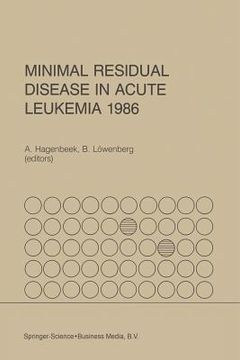Share
Minimal Residual Disease in Acute Leukemia 1986 (in English)
Hagenbeek, A. ; Löwenberg, B. (Author)
·
Springer
· Paperback
Minimal Residual Disease in Acute Leukemia 1986 (in English) - Hagenbeek, A. ; Löwenberg, B.
$ 208.41
$ 219.99
You save: $ 11.58
Choose the list to add your product or create one New List
✓ Product added successfully to the Wishlist.
Go to My WishlistsIt will be shipped from our warehouse between
Tuesday, June 11 and
Wednesday, June 12.
You will receive it anywhere in United States between 1 and 3 business days after shipment.
Synopsis "Minimal Residual Disease in Acute Leukemia 1986 (in English)"
Relapse of leukemia following successful remission-induction therapy remains a major obstacle in the treatment of patients with acute leukemia. Leukemia recurs most frequently in patients with acute myeloblastic leukemia (AML) and high risk acute lymphoblastic leukemia (ALL) following chemotherapy and less often in patients with low risk ALL and particularly in patient groups> submitted to allogeneic marrow transplantation. ' It is likely that the great majority of these recurrences originate from residual leukemic cells that survive initial remission-induction chemotherapy. Today, several research groups throughout the world place emphasis on studies concerned with the detection and treatment of 'minimal residual disease' (MRD). These investigations are conducted with the common objective to tackle the remaining cells. 'Minimal Residual Disease in Acute Leukemia: 1986' summarizes the fast advancements in this area. Several disciplines are concerned with the analysis of leukemic cells. The perspectives of cytogenetic and molecular genetic approaches for applica- tion in the detection of MRD are reviewed. In this respect, modern cyto- genetics provide highly specific tumor markers. The resolution of cyto- genetic methods can be particularly improved when combined with other techniques which select relevant subpopulations of cells. Characterization of oncogenes and gene rearrangements, including those of immunoglobulin and T-cell receptor genes, and the measurement of gene products, have been established. Techniques based on these approaches offer interesting tools for the detection of MRD. New possibilities of employing monoclonal anti- bodies are also presented.
- 0% (0)
- 0% (0)
- 0% (0)
- 0% (0)
- 0% (0)
All books in our catalog are Original.
The book is written in English.
The binding of this edition is Paperback.
✓ Producto agregado correctamente al carro, Ir a Pagar.

